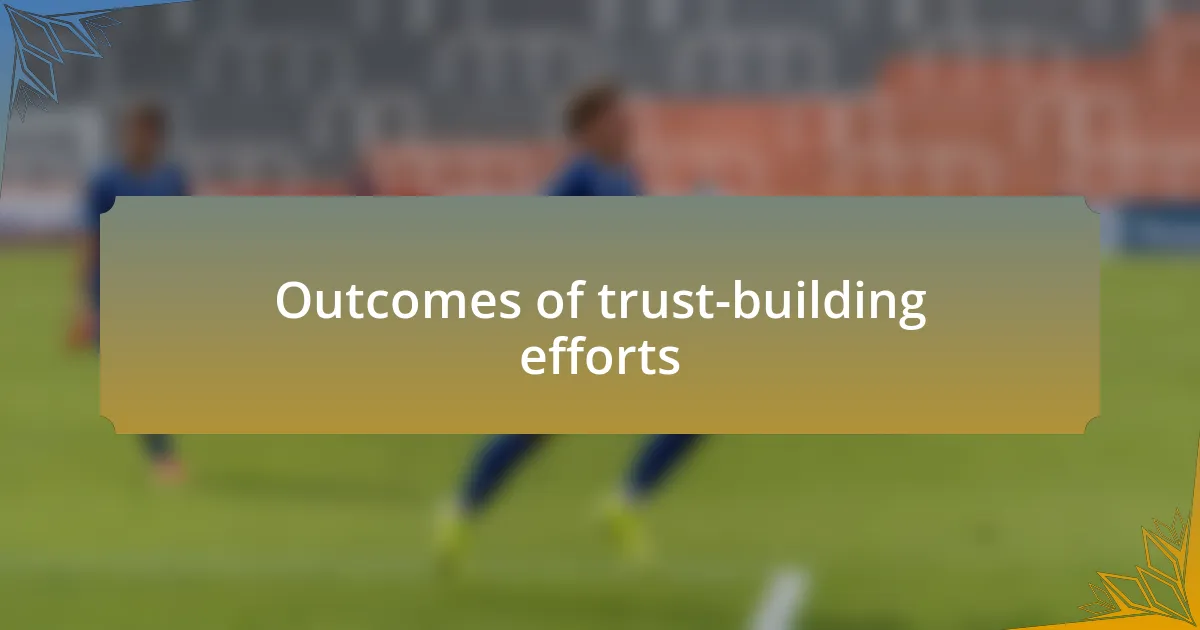Key takeaways:
- Trust in customer experience is built through consistent engagement and aligning brand promises with service delivery.
- Gathering feedback effectively involves creating a safe environment for sharing, utilizing follow-up communications, and leveraging social media interactions.
- Analyzing feedback should combine quantitative data with qualitative insights, involving team members to enrich understanding and identify trends over time.
- Sharing feedback within teams fosters a culture of transparency, leading to improved collaboration and innovative solutions.

Understanding trust in customer experience
Trust in customer experience is a delicate balance between expectation and reality. I recall an instance where I received feedback from a customer who felt misled by our advertising. It was a wake-up call that revealed just how important it is for businesses to align their promises with actual service delivery. Have you ever encountered a similar situation where your expectations didn’t match up to reality?
Building trust is not just about delivering a product; it’s about creating a consistent experience that customers can rely on. For me, this means engaging with customers actively and listening to their feedback. There was a time when I turned a negative review into a positive connection simply by taking the time to acknowledge the customer’s concerns and offer solutions. How often do we pause to listen and genuinely understand our customers’ perspectives?
When customers trust a brand, they are more likely to stay loyal and even advocate for it. This realization struck me when I noticed how a simple follow-up after a purchase could foster a deeper relationship. That connection solidified their faith in us, proving that trust is built through ongoing communication and a genuine commitment to improvement. Trust, after all, isn’t given freely; it’s earned through every customer interaction.

Key strategies for gathering feedback
When it comes to gathering feedback, one of the most effective strategies I’ve found is creating a comfortable environment for customers to share their thoughts. I remember implementing a simple, anonymous survey after a major event, and I was amazed by the candidness of the responses. Have you ever noticed how anonymity can drive people to share more freely? It created a space where even the toughest critiques felt safe to express their experiences.
Another technique that has significantly impacted my approach is using follow-up calls after a service interaction. I recall one call where a customer expressed dissatisfaction. Not only did I listen to their concerns, but I also took the opportunity to dig deeper into their experience. How often do we miss the chance to uncover underlying issues just by asking a few more questions? That extra effort can lead to invaluable insights.
Lastly, leveraging social media as a feedback tool has transformed how I connect with customers. I recall a time when we posted a question on our platform about a newly launched feature. The influx of responses not only highlighted what we needed to improve but also made our customers feel valued and part of the development process. Have you thought about how your customers could guide your journey simply by engaging them where they already spend their time? Using these strategies has made gathering feedback a dynamic, ongoing conversation rather than a one-time event.

Analyzing feedback effectively
To analyze feedback effectively, it’s crucial to sift through both qualitative and quantitative data thoughtfully. I remember when I received a mix of star ratings and narrative reviews for a recent product launch. While the numbers were solid, the comments revealed a concerning inconsistency between customer expectations and actual experiences. Have you ever pondered how numbers can sometimes hide deeper emotional truths? This realization taught me the importance of not just looking at scores but also diving into the stories behind them.
Another valuable practice I’ve adopted is involving my team in the analysis process. I once conducted a workshop where everyone shared their interpretations of feedback received from a recent survey. The diverse perspectives opened up a wealth of insights I wouldn’t have considered alone. How often do we limit ourselves by crunching numbers in isolation? Collaborating with others not only enriches the analysis but also builds a shared understanding of our customers’ needs.
Lastly, I make it a point to track feedback trends over time. After implementing changes based on initial feedback, I’ve observed how responses evolve. For instance, after redesigning our website, I noticed a gradual uptick in positive comments regarding ease of navigation. Isn’t it fascinating how continuous monitoring can reveal the real impact of our actions? This approach reinforces the idea that analyzing feedback isn’t a one-time event but an ongoing journey toward improvement.

Sharing feedback with teams
When it comes to sharing feedback with teams, transparency is vital. I’ve learned that presenting insights openly fosters a culture where everyone feels invested. I once shared both positive and negative feedback from a major campaign with my colleagues, and the initial tension quickly dissolved into a constructive discussion. Have you ever seen how honesty can pave the way for innovation? It’s about creating a safe environment where team members feel comfortable expressing their thoughts and ideas.
During a brainstorming session, I encouraged team members to voice their feelings about client feedback, which led to an unexpected breakthrough. One team member revealed how they felt the design elements weren’t capturing our brand’s spirit. I hadn’t even realized that perspective existed! Allowing space for everyone’s voice not only strengthened our collective approach but also sparked creative solutions I would have never come up with alone. Isn’t it amazing how sharing feedback can ignite collaboration?
In my experience, it helps to establish regular check-ins specifically dedicated to feedback sharing as well. I remember our team would block out time every month to discuss customer insights, which kept the momentum going and ensured we were aligned. Wouldn’t it be wonderful if every team embraced routine reflections on feedback? The ongoing dialogue we cultivated made our goals more cohesive, enabling us to adapt swiftly to our customers’ evolving expectations.

Personal experience in applying feedback
In my journey of applying feedback, I’ve found that taking the time to reflect on the comments we receive can lead to significant improvements. Once, after a customer expressed frustration with navigating our website, I dove into the issue and discovered how small tweaks in design could enhance user experience. It struck me how one piece of feedback could lead to a ripple effect, transforming an entire section of the site to better meet our users’ needs. Have you ever considered how impactful just one suggestion can be?
There’s a memorable instance when I received feedback that felt a bit harsh initially. A client pointed out that our service felt impersonal and transactional. While it stung at first, I decided to view it as an opportunity rather than criticism. By mapping out a more personalized follow-up process, we not only improved our relationship with that client but also started a trend of deeper connections across our clientele. Isn’t it fascinating how perception can shift when we truly listen?
Another valuable lesson came during a post-project review when team members shared their thoughts on how we handled client communications. I remember feeling surprised by some of their insights, especially how a lack of clarity can drive anxiety. After incorporating their feedback, we revamped our communication strategies, leading to noticeably happier clients. It made me wonder: how often do we overlook the voices within our own teams, potentially missing out on insights that could elevate our work?

Outcomes of trust-building efforts
Building trust through consistent feedback can yield remarkable outcomes. For instance, after implementing changes based on client suggestions, I observed a notable increase in repeat business. It was as if our clients felt more invested in our journey because they saw their voices reflected in our practices. Have you ever watched a relationship flourish simply because the other party felt genuinely heard?
In another experience, I organized a focus group to discuss recent purchases. The openness in that setting revealed not just what worked but also highlighted areas of concern. Participants expressed feeling valued and appreciated, which in turn fostered their loyalty. I couldn’t help but think about how powerful it is when customers realize their opinions can change the course of a company’s strategy.
Moreover, trust-building efforts also led to stronger internal team dynamics. During a brainstorming session on client feedback, I noticed that team members felt empowered to voice their ideas. This collaborative environment not only enhanced creativity but also fostered a sense of belonging within the team. Have you thought about how trust can transform not just client relationships, but also how teams operate?